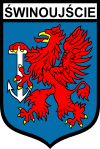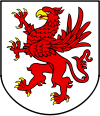Świnoujście
| Świnoujście | |||
|---|---|---|---|
 |
|||
|
|||
 |
|||
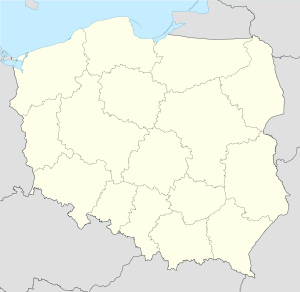 Świnoujście
|
|||
| Coordinates: | |||
| Country | |||
| Voivodeship | West Pomeranian | ||
| County | city county | ||
| Established | 12th century | ||
| Town rights | 1765 | ||
| Government | |||
| - Mayor | Janusz Żmurkiewicz | ||
| Area | |||
| - Total | 197.23 km2 (76.2 sq mi) | ||
| Elevation | 5 m (16 ft) | ||
| Population (2006) | |||
| - Total | 40,899 | ||
| - Density | 207.4/km2 (537.1/sq mi) | ||
| Time zone | CET (UTC+1) | ||
| - Summer (DST) | CEST (UTC+2) | ||
| Postal code | 72-600 to 72-612 | ||
| Area code(s) | +48 091 | ||
| Car plates | ZSW | ||
| Website | http://www.swinoujscie.pl/ | ||
Świnoujście [ɕfinɔˈujɕt͡ɕɛ] (![]() listen) (German: Swinemünde) is a city and seaport on the Baltic Sea and Szczecin Lagoon, located in the extreme north-west of Poland. It is situated mainly on the islands of Usedom and Wolin, but also occupies smaller islands, of which the largest is Karsibór island, once part of Usedom, now separated by a Piast canal dug in the late 19th century to facilitate ship access to Stettin (Szczecin).
listen) (German: Swinemünde) is a city and seaport on the Baltic Sea and Szczecin Lagoon, located in the extreme north-west of Poland. It is situated mainly on the islands of Usedom and Wolin, but also occupies smaller islands, of which the largest is Karsibór island, once part of Usedom, now separated by a Piast canal dug in the late 19th century to facilitate ship access to Stettin (Szczecin).
Since 1999 Świnoujście has been a city with the administrative rights of a county (powiat) (Polish: miasto na prawach powiatu), within West Pomeranian Voivodeship. It was previously part of Szczecin Voivodeship (1975–1998). The city lies in the geographic region of Pomerania and had a population of 41,100 in 2006.
Contents |
History
The river Świna (German: Swine) was formerly flanked by the fishing villages of Westswine and Ostswine. Towards the beginning of the 17th century it was made navigable for large ships. The Kingdom of Prussia gained the area in 1720 from Sweden, and included it in her Pomeranian province. Swinemünde was founded on the site of Westswine in 1748, fortified, and received town privileges from King Frederick II of Prussia in 1765. It served as the outer port of Stettin (Szczecin) and was administered within the Province of Pomerania. Swinemünde became part of the German Empire after the Kingdom of Prussia completed the unification of Germany in 1871.
The town had broad unpaved streets and one-story houses built in the Dutch style, which gave it an almost rustic appearance, although its industries, beyond some fishing, were entirely connected with its shipping. The river mouth, which was the entrance to the harbor, and which was regarded as the best on the Prussian Baltic coast, was then protected by two curving long breakwaters, and was strongly fortified. On the island of Wollin, on the other side of the narrow Swine, a great lighthouse was erected. In 1897 the canal of the Kaiserfahrt was opened to navigation, and this waterway between the Stettin harbour and the Baltic Sea was deepened between 1900–01. From then on Stettin could be reached directly by ships, and Swinemünde's importance diminished somewhat.
On 12 March 1945 during World War II, refugee-crowded[1][2] Swinemünde suffered heavy destruction by USAAF, an estimated 23,000[3][4][5] to 25,000[6] were killed, most of whom are buried on the Golm War Cemetery west of the town. The uncomplete German aircraft carrier Graf Zeppelin was scuttled in the harbor to save it from the advancing Soviet Army. The city was placed under Polish administration in 1945 and since then remains as part of Poland. After the war ended it was officially renamed Świnoujście. Its German population was expelled and replaced with Poles, themselves refugees from Polish areas annexed by the Soviet Union. In Winter 1945 former victims of German concentration camps and repressions during the war, now members of Polish Security Forces, acted in revenge against local Germans and killed 40 Civilians. They were later sentenced for robbery by a Polish court.[7] The Red Army occupied part of the city until 1957 and the navy harbour until c. 1990.
Climate
Świnoujscie is situated in the oceanic climate, which is characterized by mild winters and relatively cool summers. Very large influence on the climate of the city is the location of the Baltic Sea. Świnoujscie often in winter is the warmest city in Poland.
| Climate data for Świnoujście | |||||||||||||
|---|---|---|---|---|---|---|---|---|---|---|---|---|---|
| Month | Jan | Feb | Mar | Apr | May | Jun | Jul | Aug | Sep | Oct | Nov | Dec | Year |
| Record high °C (°F) | 13.5 (56.3) |
13.1 (55.6) |
19.7 (67.5) |
25.1 (77.2) |
29.4 (84.9) |
31.8 (89.2) |
34.4 (93.9) |
33.2 (91.8) |
30.2 (86.4) |
24.2 (75.6) |
17.7 (63.9) |
14.6 (58.3) |
34.4 (93.9) |
| Average high °C (°F) | 3.9 (39) |
4.2 (39.6) |
8.8 (47.8) |
11.2 (52.2) |
16.9 (62.4) |
19.1 (66.4) |
20.6 (69.1) |
20.1 (68.2) |
16.6 (61.9) |
12.0 (53.6) |
6.2 (43.2) |
4.7 (40.5) |
12.0 (53.6) |
| Daily mean °C (°F) | 0.4 (32.7) |
0.9 (33.6) |
4.5 (40.1) |
8.7 (47.7) |
13.2 (55.8) |
15.8 (60.4) |
17.2 (63) |
16.9 (62.4) |
13.9 (57) |
9.4 (48.9) |
4.6 (40.3) |
1.7 (35.1) |
8.9 (48) |
| Average low °C (°F) | -3.1 (26.4) |
-2.5 (27.5) |
0.1 (32.2) |
6.2 (43.2) |
9.5 (49.1) |
12.5 (54.5) |
13.8 (56.8) |
13.7 (56.7) |
11.2 (52.2) |
6.8 (44.2) |
3.0 (37.4) |
-1.4 (29.5) |
5.8 (42.4) |
| Record low °C (°F) | -22.3 (-8.1) |
-23.6 (-10.5) |
-17.3 (0.9) |
-6.0 (21.2) |
-2.3 (27.9) |
1.0 (33.8) |
4.0 (39.2) |
2.5 (36.5) |
-2.2 (28) |
-5.3 (22.5) |
-11.6 (11.1) |
-15.1 (4.8) |
-23.6 (-10.5) |
| Precipitation mm (inches) | 33 (1.3) |
30 (1.18) |
37 (1.46) |
45 (1.77) |
49 (1.93) |
64 (2.52) |
82 (3.23) |
68 (2.68) |
41 (1.61) |
49 (1.93) |
44 (1.73) |
46 (1.81) |
588 (23.15) |
| Avg. precipitation days | 17 | 14 | 16 | 12 | 13 | 15 | 16 | 15 | 13 | 16 | 17 | 16 | 180 |
| Sunshine hours | 38 | 55 | 92 | 147 | 206 | 234 | 223 | 211 | 147 | 96 | 44 | 31 | 1,524 |
| Source #1: www.imigw.pl | |||||||||||||
| Source #2: http://www.stat.gov.pl/cps/rde/xchg/gus | |||||||||||||





Population
- 1900: 10,300
- 1925: 18,200
- 1938: 30,100
- 1947: 5,800
- 1960: 17,000
- 1970: 28,100
- 1975: 42,400
- 1980: 47,100
- 1990: 43,300
- 1995: 43,361
- 2003: 41,188
- 2004: 41,098
- 2005: 40,993
- 2006: 41,100
Source:
- 1900, 1925, 1938, 1947:
- 1960, 1970, 1975, 1980:[8]
- 1990:
- 1995, 2003, 2004, 2005:[9]
- 2006: Polish Wikipedia, pl:Świnoujście
Infrastructure
Transport
The town is located on both banks of the river Świna, and since there is no road connection across it, transport is provided by regular ferries. Because the west section is otherwise wholly disconnected from the rest of Poland, this service is free of charge. Under current plans, a tunnel will be built under the river some time before 2013.
Świnoujście has the largest and most modern ferry terminal in Poland, with regular connections to Denmark and Sweden. The city lies at the northern terminus of Polish National Route 3 (DK3, in the future express road S3), which is in turn part of the European route E65 running across Europe from Sweden to Greece. Świnoujście has four railway stations on the eastern bank of the river Świna, on Wolin island, with regular regional connections to Szczecin and long-distance connections to other cities in Poland.
Land border controls were abolished 21 December 2007, and free automobile traffic to and from Germany was allowed for the first time since 1945, (when it was part of German territory), as Poland implemented the Schengen Agreement. From 20 September 2008 the city has a railway connection to its western portion as well, when the railway line to Ahlbeck was extended eastward to Świnoujście, ("Świnoujście Centrum") giving it a direct link to the German railway network. The nearest airport at Heringsdorf in Germany, 13 km west of Świnoujście, will likely become more important for travelling to the city, if it ever acquires year-round scheduled passenger connections; it currently has a number of summer connections to German cities only. The nearest airport with year-round traffic is the Szczecin-Goleniów "Solidarność" Airport, 80 km southeast in Poland.
Tourist attractions
- The former town hall houses the Museum of Deep Sea Fishing. Exhibits include the history of sea fishing, sea animals, the town and its region, and old navigation equipment.
- The Angel's Fort, built from 1845–1858, is a replica of Hadrian's Mausoleum (Castel Sant'Angelo in Rome).
- Concerts and art exhibitions are held at the Western Fort. Built between 1843–1863, it has been modernized a few times in the past. From after World War II until 1962 it was a headquarters of the Red Army.
- The 18th Christ the King Church in the centre of the town was erected on the site of a Gothic temple. A wooden ship replica is in the main nave. Organ concerts are presented during the summer.
- The neo-Gothic church of the Holy Mother "Stella Maris" has stained glass windows of great artistic value. It was erected at the end of 19th century.
- The "well" is a preserved tower of a Protestant church damaged during World War II and demolished afterwards.
- A shelter built in 1942 has the exposition "The town yesterday and now", presenting pictures of the town's history and other exhibits.
- The stawa Młyny is a navigation beacon built in the form of a windmill on the 19th century breakwater.
- The lighthouse, built in 1858, is at 68 m the highest lighthouse on the Baltic sea.
- The Eastern Fort, or Gerhard's Fort, is one of three preserved forts from the 19th century. An exhibition inside the building presents the history of the town's forts, as well as objects found there.
- The district of Karsibór contains an Evangelical cemetery established in the first half of 19th century.
- The Gothic church from the 15th century contains an altar from the 15th century and a pulpit from the 17th century.
- A monument honours the memory of Royal Air Force pilots shot down while raiding the town in April 1945.
- Karsiborska Kępa, an island near the town, contains a bird sanctuary with approximately 140 species.
International relations
Twin towns — Sister cities
Świnoujście is twinned with:
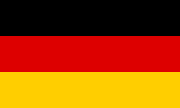 Heringsdorf, Germany since 2007
Heringsdorf, Germany since 2007 Nordenham, Germany since 1992
Nordenham, Germany since 1992 Ostvorpommern, Germany since 1998
Ostvorpommern, Germany since 1998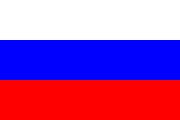 Svetly, Russia since 1993
Svetly, Russia since 1993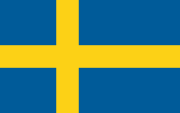 Ystad, Sweden since 1990
Ystad, Sweden since 1990
Districts of Świnoujście
- Przytór
- Karsibór
- Wydrzany
- Łunowo
- Ognica
Professional teams
- Flota Świnoujście - plays in the second division of the Polish football league, Polish First League
- Prawobrzeże Świnoujście - plays in B-Klasa. (7 League)
Notable residents
- Alfred Ploetz (1860–1940)
- Elsa von Freytag-Loringhoven (1874–1927), artist
- Christel Peters (1916–2009), actress
- Hans-Werner Grosse (* 1922), pilot
- Gisela Stein (1935–2009), actress
Cities and towns near Świnoujście
- Szczecin (Poland)
- Międzyzdroje (Poland)
- Kamień Pomorski (Poland)
- Nowe Warpno (Poland)
- Ueckermünde (Germany)
- Ahlbeck (Germany)
See also
- Dreikaiserbäder (Ahlbeck, Heringsdorf, and Bansin)
- Ports of the Baltic Sea
References
- ↑ Torsten Mehlhase, Flüchtlinge und Vertriebene nach dem Zweiten Weltkrieg in Sachsen-Anhalt: ihre Aufnahme und Bestrebungen zur Eingliederung in die Gesellschaft, LIT Verlag Berlin-Hamburg-Münster, 1999, p.256, ISBN 3825842789: 70,000 refugees in Swinemünde on 12 March 1945
- ↑ Hanno Ballhausen, Friedemann Bedürftig, Chronik des Zweiten Weltkriegs, wissenmedia Verlag, 2004, p.300, ISBN 3577143673: 100,000 people in Swinemünde on 12 March 1945 (refugees+locals)
- ↑ Samuel W. Mitcham, German Order of Battle: 291st-999th Infantry divisions, named infantry divisions, and special divisions in World War II, Stackpole Books, 2007, p.232, ISBN 0811734374
- ↑ Petra Dubilski, Ostseeküste- Mecklenburg-Vorpommern, DuMont Reiseverlag, 2003, p.200, ISBN 3770159268
- ↑ Daniela Schetar-Köthe, ADAC Reiseführer Polen, ADAC Verlag DE, 2007, p.98, ISBN 3899054911
- ↑ Werner Buchholz, Pommern: Pommern, Siedler, 1999, p.514, ISBN 3886802728
- ↑ Adam Zadworny,They Were Killing Germans in Revenge, 18 January 2008
- ↑ Rocznik Statystyczny 1981, Główny Urząd Statystyczny, Warszawa 1981.
- ↑ Official website of Świnoujście: O mieście -> Świnoujście w liczbach (Polish)
External links
- Official website of Świnoujście (English) (Polish) (German)
- Tourist Information for Swinemünde (German) (Polish)
- A Few Views of Swinoujscie in Old Postcards
- Świnoujście / Swinemuende (English) (Polish) (German)
|
||||||||||
|
|||||||
|
||||||||||||||||||||||||||||||||||||||||||||
|
|||||||||||||||||||||||||||||||||||||||||||||||||||||||||||||||

